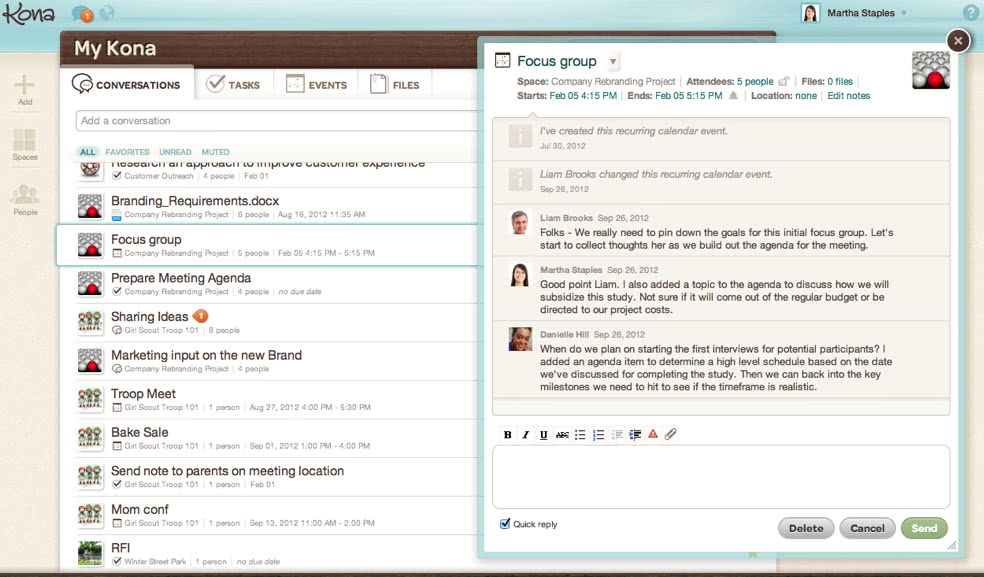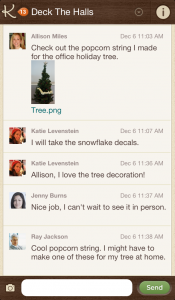Collaboration
Behind the Software Q&A with Kona Lead Scott DeFusco

There’s no shortage of collaboration tools in the software world right now. More than a few of them are actually quite good at what they do, but few, if any, are good enough to cross the boundaries of the office and double as a tool for personal communication and organization.
The team behind Kona, the new collaboration solution from veteran software developer Deltek, has set its sights on destroying that barrier. We talked to Deltek VP of products and Kona lead Scott DeFusco about some of the novel marketing and innovative features behind the solution.
Just what was the origin behind the Kona project? What motivated Deltek to get started in the whole project/team collaboration segment?
Scott DeFusco: Deltek’s background and historical success has been empowering project-based businesses around the world that rely on teams to deliver value to customers. So this puts us in a unique position with tons of experience and exposure to various kinds of teams working within our customer base – with flagship products that address needs ranging from accounting and HR to resource planning and project management.
So me and Jeff Eckerle, the co-founders of Kona within Deltek, experienced the dysfunction of teams on a regular basis. For example, one of our premier clients did an internal audit on their projects and, by their measure; nearly 60-70 percent of their projects were failing to some degree. The main reason? Poor team performance. Our experiences and challenges like that got us energized to attack the problem.
As we set out to try and solve the problem, we decided not to predispose ourselves to a solution. Many people do exactly that and they miss the real answers because their view is already defined. For example, if you look at some of the solutions out there, some decided the answer is creating Facebook for business. Or they say, “Tasks are the answer, let’s go create the best task management app, frame people’s conversations around specific tasks and that’ll be the answer.”
We went down a different path of discovery and purposely spoke with a variety of non-Deltek customers. For example, we met with Anheuser-Busch and United Healthcare. We talked to universities and many small businesses. We did a lot of listening and used those insights as the inspiration for what is now Kona.
Right now it seems like collaboration software is a pretty crowded, pretty competitive market. Asana in particular has become a high-profile competitor. How are you setting yourselves apart from other solutions offering similar services?
At the time we started, we did not see the collaboration market as being so mature. Many of these solutions have obviously been out there for years – like Jive. But, in terms of Asana, we weren’t aware of them when we were doing our research.
We didn’t want to assume the answer and say, “Okay, what the customer needs is a task management application. We feel that we’ve attacked the problem in a significantly different way. While we do have task management as a major part of our solution, the core of Kona is setting up a space you can invite people into privately and then start having conversations on a topic that may not even be around specific tasks, a calendar event or a file to be reviewed yet. That’s how people think. They don’t need a task to have a conversation. Conversations flow more organically than that and so should the solution. This is why being conversation-centric has been one of the most significant aspects of Kona compared to others. Kona brings project and task management, private and enterprise social networking, and personal productivity all together – centered around the ways that people actually communicate and collaborate each and every day, through technology and in-person.
One of the major differentiators dates back to what we learned during those early days and is still one of our philosophical tenets today. We were focusing on team dysfunction in their business. However, people couldn’t wait to share how these same challenges went beyond just their business lives and activities. People would say, “I’m doing my MBA. I have a project with the other people in my MBA program and we’re struggling with this.” Or, “I’ve got my kids’ soccer team that I coach and I’m having serious trouble coordinating between all of these parents and the coaches.”
We kept hearing these examples that crossed people’s lives and that’s one of the things about Kona that really makes us unique. We started from the vantage point that this is not just a business problem – it’s a people problem. Those are the gems you get when you take the time to really listen, learn, and understand the problem.
So, when you look at Kona, it’s all about people … and very specifically focused on conversations.
Another thing we learned along the way is the importance of the individual. So, you would think from our background in project management we would have come in and said, “Okay, we need a better project management app.” Instead of that approach, we purposely avoided things like Gantt charts. We’re not designing this specifically for the project manager. There’s a ton of solutions out there that cater to project managers but the problem is their teams don’t like to use them. We focused on making project managers successful in a different way by making the people on their teams more connected, more visible and more effective contributors.
We still address many of the administrative and IT-related functions, but our primary focus was on usability and ensuring that the user interface would be light, elegant and easy to maneuver … and we’re really holding firm to that premise – philosophically and tactically. The term we’ve used form the beginning to guide us is “delightful.” That’s always the goal.
The other unique element: Kona is free. When we say free, we really mean free. We do have a business version (Kona Business) that we launched in July, but the free version goes beyond what you see with Asana, Basecamp or the other so-called free solutions throughout the social collaboration marketplace. We don’t limit the amount of spaces that an individual can create. We don’t limit the amount of people they can invite, but we have built premium business features that have already proven to be very attractive to small and large businesses. We want the value of Kona to spread throughout the community and that’s been a much stronger market model for us.
What kind of response have you gotten for the free version of Kona and, in general, how does that free model fit into your whole marketing scheme for the product?
I’m going to give you a really good example on how we designed this to work and how that’s actually happening.
We have thousands and thousands of people and businesses around the world using Kona today. If you look at the people who are using it, we have families using Kona to communicate with extended family members – since it feels better and more private than something like Facebook or email. We have a lot of sports teams using it, both coaches and team managers. There are people managing Girl Scout troops. We have parent/teacher organizations depending on Kona.
Education has been an interesting niche for us where we have the middle school and high school administrators relying on it and college professors using it with their students. So, we have an incredible mix of both personal and business use cases. These range from small businesses to larger enterprises – and those businesses vary in terms of vertical market focus.
Here’s a good example of how we built the model and an actual reference point of where it’s working. A gentleman named Zach Lezberg was introduced to Kona from a family member and he started using it as a way for the family to share and communicate. When he saw that he said, “Wow, this would be good for my business – The Show Producers.”
The Show Producers create and manage small business expos in major cities around the United States. Zach began using the free version for his business. When we introduced Kona Business, he considered the extended feature set to be tremendously valuable for him and wanted to start using Kona to coordinate with the hundreds of vendors attending these expos – as well as the registered attendees. He went from using the free version in his personal life to implementing Kona Business in his professional endeavors.
That’s the beauty of the Kona model. We have a paying customer who was introduced to the product by a family member (through the free version) and saw the value of Kona Business. As a result, he’ll introduce Kona to thousands of people, many of whom might be interested in Kona Business. We’re going to repeat that cycle over and over again.
Deltek has a really diversified product lineup. When you were designing Kona was it specifically meant to be used as part of larger suite of Deltek products or do you want to push it as a standalone solution?
We literally treated this like a startup, extracted ourselves from the product line we were managing and formed a separate team to build the product.
Obviously, doing this within Deltek has great advantages in terms of the rich experience, resources, and customer base we can tap. And, the company has been incredibly supportive. However, we also didn’t predispose ourselves to existing technologies, designs, or processes. This provided us with the flexibility to choose the technologies and methodologies that were right for Kona. For example, we are very agile and release versions of Kona every three weeks. That cadence doesn’t necessarily work with a large ERP product. We also knew that that it was going to be a great benefit to have access to 16,000 customers that would find value in Kona, but we built Kona from the ground up to be broader than that. While we always planned for Kona to integrate with the broader Deltek portfolio of products, we did not let that guide our design decisions.
So, the marriage works great. We have this great company, product line, and channel to leverage. But, we also built Kona as a standalone solution to go after a broader market, which makes the opportunity for Deltek expansive.
One of the problems we’ve run into with collaboration tools is that the mobile app is often underpowered, or a glorified page viewer. What’s Kona’s mobile app like?
From the beginning, we knew that we were going after the end user as our main constituent and these folks are very mobile-centric in their use cases and activities. We’ve seen mobile as a first-class citizen since day one.
I’ll just give an example of how we might approach things a little differently than some other products, because I certainly get what you’re saying. I’ve seen the same thing. Let’s consider polling capabilities.
Some solution, like Yammer for example, have polling functionality where you can create a poll, ask people questions and answer them. When you go into their mobile app (which is where many people would be responding to a poll these days), you basically get directed back out to the website versus keeping the experience in the mobile app. We approached this very differently. We have several different kinds of polling and it’s all very slick. There’s functionality there that lets you run an anonymous-versus-public poll. You can hover over the response chart to see the people’s results, and it’s all in real-time – very dynamic and interactive. It works on Kona.com and it works on Kona Mobile.
When we developed that, it wasn’t a case of us saying, “Well, let’s throw it in the web app and then we’ll get to mobile when we hear people complaining about when we’d be tackling mobile.” When we address features like that it’s for the whole service. That’s what people expect.
You just launched on July 18. How has it been going so far?
It’s been really successful. We had an early adopter program where we had businesses using it for a couple of months now providing us with feedback. From there we generated some pent-up demand, so we got off to a start that was much faster than we thought. I think we’re getting close to 20 purchases already and that’s just right out of the gate.
We have a lot of work ahead of us, but we’re really jazzed about the waves we’re seeing out there and that’s not just marketing speak. I have to say that of all the products I’ve represented and helped develop over the years none of them have received the level of feedback we’ve had so far with Kona. It’s a really great validation on design approach. A really great validation of the idea of not creating a Blackberry that you can use at work, but instead an iPhone that you want to use at home.
Our goal from the beginning was similar to that of the iPhone. We wanted a technology that would transcend your life and feel just as good at home as it does at work.
We had one guy, for example, a government contractor, and he was one of our early adopters. He used Kona with 20 other subcontractors to go after a major government contract. And they soon moved on to using Sharepoint, but yet he uses it for personal use cases every day. So it’s just been really heartening to see that kind of validation of what we’ve set out to achieve.
What’s the biggest challenge you guys are currently facing? That could be either business wise or technology wise and how are you addressing it?
The biggest challenge I see at this point is expanding awareness and exposure. We feel like we have this great product that’s ready to empower people, teams and organizations around the world. For example, we just won a deal against Salesforce.com where a company was going to buy one of their collaboration tools. They found out about Kona Business and went with us instead. We’ve had situations like that with Asana and Basecamp as well.
We’ve been very quiet up until this point and now it’s about getting the word out. When people try Kona, they experience that “a-ha moment” where they realize that we aren’t just another collaboration vendor. We’re really so much more, connecting the benefits of project and task management, private or enterprise social networks (ESNs) and personal productivity in one solution.
I continuously review and analyze a whole list of competitors we’ve explored–and I have a healthy respect for them. Competition is a great thing–but when you look at them, they all seem to be following a template. Maybe it’s about a feature war. Showing how different and unique Kona is has become one of our primary objectives, especially as we keep hearing similar responses from the Kona community, “Wow, these guys have really done something different here that we haven’t seen before.”
Our other challenge is holding onto our original premise of making it simple. That sounds like such an easy thing to do, but we get pressures from many different angles. Companies ask us about private-labeling Kona with their own company branding and we’ve really resisted that, because to us that’s like you saying you want to brand an iPhone. That’s not going to feel comfortable.
Blackberry tried to do something like that with its new model for work mode versus personal mode and they’re finding out that it doesn’t work. People just don’t switch their minds around that way.
Is this going to be a delightful experience? The minute that we start seeing that might not be the case, we have to go back to where we started and focus on keeping it simple. That’s another differentiator that separates Kona from others – the defining combination of simplicity and power through a delightful experience, whether you’re on a computer, tablet or mobile device … for your professional or personal life efforts. We’re looking forward to Kona’s future.








